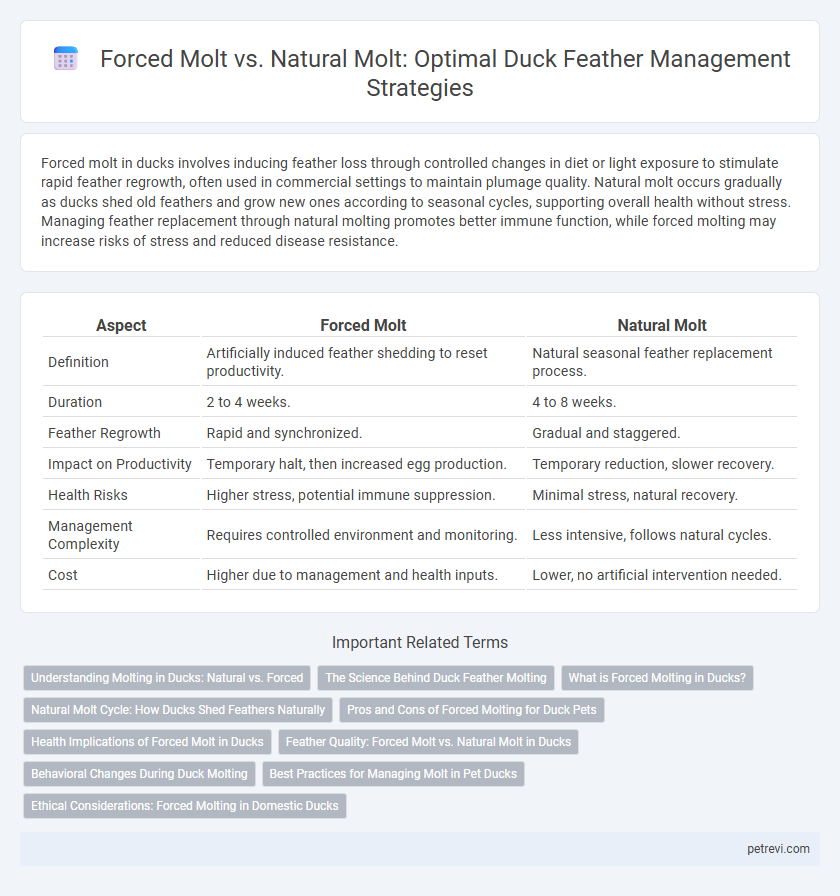Forced molt in ducks involves inducing feather loss through controlled changes in diet or light exposure to stimulate rapid feather regrowth, often used in commercial settings to maintain plumage quality. Natural molt occurs gradually as ducks shed old feathers and grow new ones according to seasonal cycles, supporting overall health without stress. Managing feather replacement through natural molting promotes better immune function, while forced molting may increase risks of stress and reduced disease resistance.
Table of Comparison
| Aspect | Forced Molt | Natural Molt |
|---|---|---|
| Definition | Artificially induced feather shedding to reset productivity. | Natural seasonal feather replacement process. |
| Duration | 2 to 4 weeks. | 4 to 8 weeks. |
| Feather Regrowth | Rapid and synchronized. | Gradual and staggered. |
| Impact on Productivity | Temporary halt, then increased egg production. | Temporary reduction, slower recovery. |
| Health Risks | Higher stress, potential immune suppression. | Minimal stress, natural recovery. |
| Management Complexity | Requires controlled environment and monitoring. | Less intensive, follows natural cycles. |
| Cost | Higher due to management and health inputs. | Lower, no artificial intervention needed. |
Understanding Molting in Ducks: Natural vs. Forced
Natural molting in ducks occurs seasonally, allowing gradual feather replacement that supports consistent insulation and flight capability while minimizing stress. Forced molting, often induced in commercial poultry management, accelerates feather loss through controlled fasting or environmental adjustments to synchronize molt and enhance reproductive performance. Understanding the physiological and welfare implications of both methods is crucial for optimizing feather management and overall duck health.
The Science Behind Duck Feather Molting
Forced molt accelerates the shedding and regrowth cycle in ducks by manipulating environmental factors such as light exposure and diet, leading to rapid feather renewal and often improved plumage quality for commercial production. Natural molt occurs seasonally, regulated by hormonal changes triggered by photoperiod and temperature variations, resulting in gradual feather replacement that supports the duck's health and energy balance. Understanding the endocrinological mechanisms behind molting, including thyroid and pituitary hormones, helps optimize feather management strategies to enhance duck welfare and productivity.
What is Forced Molting in Ducks?
Forced molting in ducks is a controlled practice used primarily in commercial duck farming to induce a rapid feather shedding and regrowth cycle. This process involves manipulating environmental factors such as lighting, feed, and water availability to stimulate molting, enhancing reproductive performance and extending the productive lifespan of laying ducks. Unlike natural molting, forced molting accelerates feather replacement but requires careful management to avoid stress and health issues in the birds.
Natural Molt Cycle: How Ducks Shed Feathers Naturally
Ducks undergo a natural molt cycle where they systematically shed and regrow feathers to maintain optimal insulation, waterproofing, and flight efficiency. This process typically occurs annually, triggered by hormonal changes linked to daylight and environmental conditions, ensuring a gradual replacement without compromising the bird's health or mobility. Natural molting supports ducks' overall well-being and feather quality, contrasting with forced molt practices that aim to accelerate feather regeneration artificially.
Pros and Cons of Forced Molting for Duck Pets
Forced molting in duck pets accelerates feather renewal by inducing stress through controlled fasting or environmental changes, promoting rapid regrowth and improving plumage quality. However, this process can cause significant health risks such as weakened immunity, increased susceptibility to disease, and elevated stress levels, potentially leading to long-term welfare issues. Natural molting occurs gradually without external manipulation, supporting overall duck health but resulting in slower feather replacement and extended periods of reduced activity and appearance.
Health Implications of Forced Molt in Ducks
Forced molt in ducks, often induced through feed restriction or environmental stress, can lead to significant health risks including weakened immune function, increased susceptibility to disease, and elevated stress hormone levels. Unlike natural molt, which allows ducks to gradually replace feathers while maintaining physiological balance, forced molt disrupts metabolic processes and may result in muscle loss and impaired organ function. Prioritizing natural molt supports optimal feather regeneration, immune resilience, and overall welfare in duck populations.
Feather Quality: Forced Molt vs. Natural Molt in Ducks
Forced molt in ducks induces rapid feather replacement through controlled feed restriction and environmental adjustments, often resulting in lower feather quality characterized by brittle and less dense plumage. Natural molt occurs gradually with seasonal changes, allowing for the development of stronger, denser feathers that improve insulation and water repellency. Studies show that ducks undergoing natural molt typically exhibit enhanced feather durability and better overall plumage condition compared to those subjected to forced molting practices.
Behavioral Changes During Duck Molting
During forced molt, ducks experience abrupt hormonal shifts leading to increased aggression, reduced feeding, and heightened restlessness compared to the gradual behavioral adjustments seen in natural molting. Natural molting supports steady feather regeneration with minimal stress, maintaining normal foraging and social behaviors. Understanding these behavioral changes optimizes feather management and animal welfare in duck production systems.
Best Practices for Managing Molt in Pet Ducks
Forced molt in ducks involves controlled stress factors like food restriction to accelerate feather replacement but can negatively impact health and welfare. Natural molt allows ducks to shed and regrow feathers gradually without stress, supporting overall well-being and maintaining immune function. Best practices for managing molt in pet ducks emphasize providing balanced nutrition, minimizing stress, and allowing natural environmental cues to regulate feather renewal effectively.
Ethical Considerations: Forced Molting in Domestic Ducks
Forced molting in domestic ducks involves inducing stress through feed restriction or environmental manipulation to accelerate feather shedding, raising significant ethical concerns related to animal welfare. Natural molting allows ducks to shed and regrow feathers without artificial intervention, supporting healthier physiological processes and reducing stress-induced health issues. Ethical considerations highlight that forced molting can cause hunger, weakened immunity, and increased susceptibility to disease, making natural molting the preferred method for humane feather management.
Forced molt vs Natural molt for Duck feather management Infographic

 petrevi.com
petrevi.com